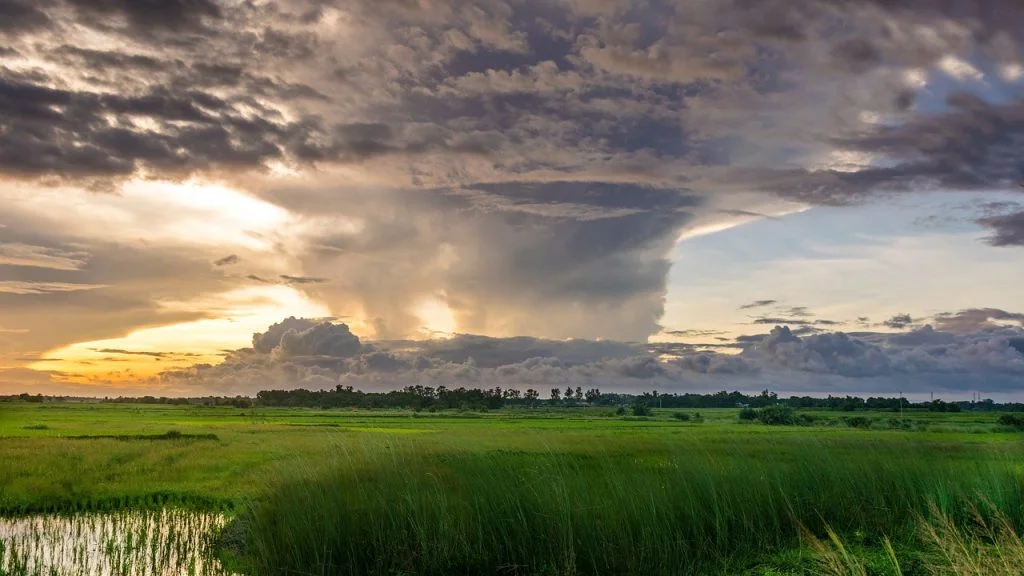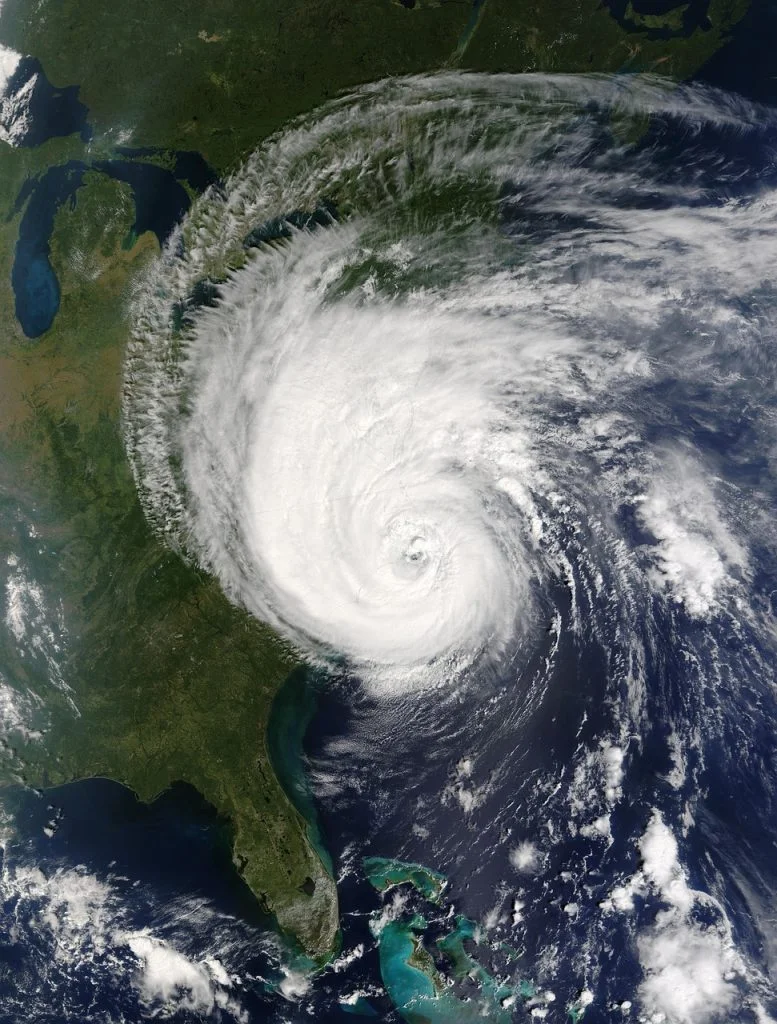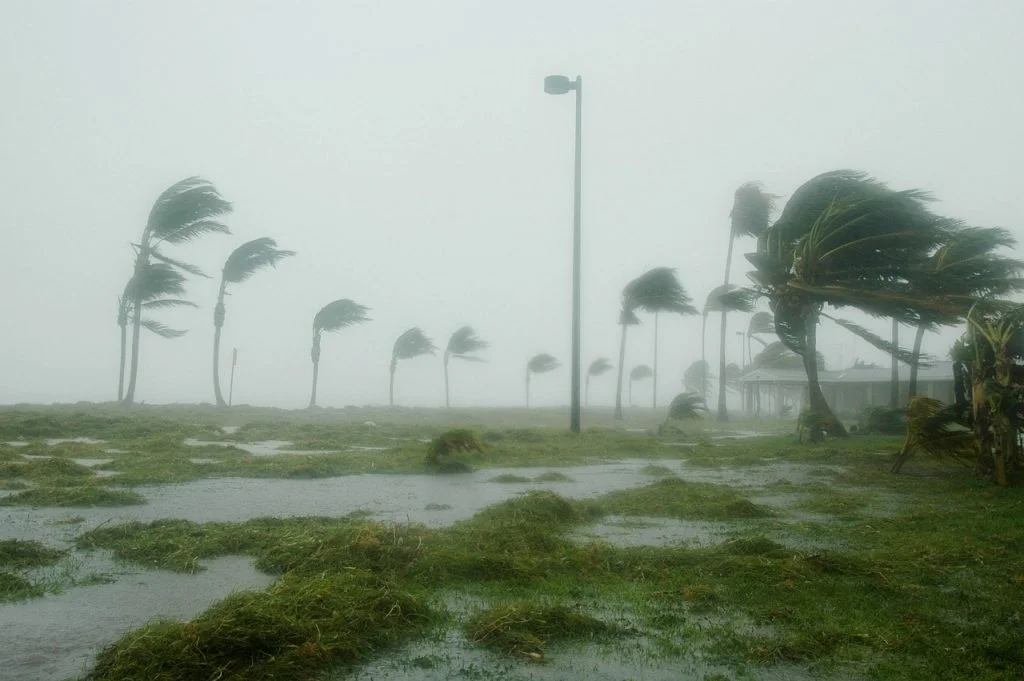Picture this: a massive wind that’s not only strong enough to rearrange your garden but also sassy enough to name itself.
Welcome to the world of hurricanes, nature’s way of mixing things up, literally. These spinning behemoths, often with names less intimidating than your average pet, pack more punch than a boxer in a bad mood.
Ever wondered what it’s like inside the eye of the storm? Hint: It’s not the best place for a picnic! Let’s start our journey.
A storm was a tempest, a hurricane was a storm with a temper.
Erik Larson
Hurricane Facts
Get ready to be swept away by the incredible world of hurricanes. As you read through, make sure to read carefully because I created a quiz to challenge your knowledge and see if you’ve weathered the storm of facts.
- Hurricanes are large, swirling storms with winds of 74 miles per hour or higher.
- They form over warm ocean waters, usually starting as a tropical wave.
- A hurricane’s eye is typically calm and clear, surrounded by a wall of thunderstorms.
- The right side of a hurricane is often the most dangerous in terms of storm surge, winds, and tornadoes.
- Hurricanes can release more energy than 10,000 nuclear bombs.
- The term “hurricane” is used only in the Atlantic and northeastern Pacific regions.
- In the northwestern Pacific, the same type of storm is called a “typhoon”.
- Australia and the Indian Ocean region refer to these storms as “cyclones.”
- Hurricanes are categorized on the Saffir-Simpson Hurricane Wind Scale, from Category 1 to 5.
- A Category 5 hurricane has winds exceeding 157 mph.
- The Coriolis Effect is essential for the formation of hurricanes.
- Hurricanes can’t form exactly on the equator due to the lack of Coriolis force.
- The Atlantic hurricane season runs from June 1 to November 30.

- The Pacific hurricane season starts a little earlier, from May 15.
- A hurricane’s primary energy source is the release of heat from condensation.
- Hurricanes often weaken when they hit land, as they are cut off from their primary energy source.
- The deadliest U.S. hurricane was the 1900 Galveston Hurricane, killing an estimated 8,000 to 12,000 people.
- The costliest hurricane in U.S. history was Hurricane Katrina in 2005, causing over $125 billion in damage.
- Hurricane Mitch, in 1998, was one of the deadliest Atlantic hurricanes, killing over 11,000 people in Central America.
- Storm surge is often the most dangerous part of a hurricane, causing 90% of hurricane deaths.
- Hurricanes can spawn tornadoes, usually in the right-front quadrant of the storm.
- The hurricane’s eye can range in size from 2 miles to over 200 miles in diameter.
- Climate change is believed to be increasing the intensity and frequency of hurricanes.
- Hurricanes have been observed on other planets, like the Great Red Spot on Jupiter.
- The WMO (World Meteorological Organization) retires the names of particularly deadly or costly hurricanes.
- A hurricane’s rain bands can stretch for hundreds of miles from the center.
- Wind speed isn’t the only dangerous aspect; flooding from heavy rains can be just as threatening.
- The first hurricane to be officially named was Hurricane George in 1947.

- Hurricanes in the Southern Hemisphere rotate clockwise, opposite to those in the Northern Hemisphere.
- Barometric pressure in hurricanes can drop to extremely low levels, which is central to their power.
- Storm chasers often follow hurricanes to collect data and improve forecasting models.
- The sea surface temperature must be above 26.5 degrees Celsius (80 degrees Fahrenheit) for a hurricane to form.
- Hurricanes can move erratically, and their paths can be hard to predict.
- The size of a hurricane can influence its overall destructiveness more than the wind speed.
- Outer rain bands can reach far from the hurricane’s center, causing floods even in distant areas.
- Some hurricanes have lasted for over a month before dissipating.
- Super Typhoon Haiyan (2013) was one of the most powerful tropical cyclones ever recorded.
- The Galveston Hurricane of 1900 remains the deadliest natural disaster in U.S. history.

- Hurricanes absorb heat from the ocean, and release it through the condensation of water vapor in thunderstorms.
- Storm surges are caused by the wind pushing ocean water toward the coast.
- The name “hurricane” comes from “Huracan,” a Mayan god of wind, storm, and fire.
- Florida is the U.S. state most frequently hit by hurricanes, due to its peninsula shape and warm waters.
- The Great Miami Hurricane (1926) is considered the costliest U.S. hurricane when adjusted for inflation.
- Hurricanes can generate huge waves, called swells, that travel thousands of miles.
- Technology advancements in satellites and radars have significantly improved hurricane tracking and prediction.
- Global warming is expected to increase the intensity but possibly decrease the frequency of hurricanes.
- The eye wall replacement cycle can cause a hurricane to increase in size and decrease in intensity, temporarily.
- NOAA’s Hurricane Hunters fly into hurricanes to gather vital data for forecasts and research.
- The most intense hurricane ever recorded in the Atlantic basin was Hurricane Wilma in 2005.
- Storm surges can cause more widespread damage than the high winds of a hurricane.
Hurricane Myths

Having explored some interesting facts about hurricanes, let’s now navigate around some myths about them. We will shine a light on the actual truth behind these myths.
- Opening Windows Reduces Damage
Opening windows during a hurricane is a common misconception. In reality, it can actually increase the pressure inside the house, leading to more damage. It’s best to keep windows securely closed. - Taping Windows Prevents Shattering
Taping windows won’t prevent them from breaking in a hurricane. Instead, it’s more effective to use storm shutters or impact-resistant windows to protect your home. - Hurricanes Only Affect Coastal Areas
While coastal areas are more susceptible, hurricanes can also cause significant damage inland. Heavy rains, flooding, and high winds can extend hundreds of miles from the coast. - The Bigger the Hurricane, the More Dangerous
Size isn’t the only indicator of a hurricane’s danger. Smaller hurricanes can be just as destructive, especially if they move slowly or stall over an area, causing prolonged wind and flooding. - Category 1 Hurricanes Aren’t Serious Threats
Even Category 1 hurricanes can be dangerous, bringing strong winds, heavy rain, and flooding. It’s important to take all hurricanes seriously and follow evacuation and safety guidelines.
Hurricane Quotes

Let me share with you some of my favorite quotes about hurricanes. Feel free to share yours in the comments so I can add them to the list.
You can’t stop the waves, but you can learn to surf.
Maya Angelou
Angelou uses a metaphor for hurricanes to imply that while we cannot control natural disasters, we can learn to adapt and find strength in adversity.
A hurricane was my first dance.
Rick Riordan
Riordan uses this quote to symbolize a powerful, transformative experience, likening it to the overwhelming force of a hurricane.
The hurricane’s outstretched wings.
William C. Bryant
Bryant poetically describes the vast and destructive power of a hurricane, giving it an almost mythical quality.
Facing it, always facing it, that’s the way to get through. Face it.
Joseph Conrad
Conrad’s quote, often associated with enduring hardships like hurricanes, encourages confronting challenges head-on.
The edge of the sea is a strange and beautiful place.
Rachel Carson
Carson reflects on the beauty and mystery of the sea, which can also be the birthplace of hurricanes, highlighting nature’s dual aspects of beauty and danger.
Hurricane FAQ

After reading all these beautiful quotes, we’re moving on to the FAQ section. Take your last notes because the hurricane quiz is just ahead.
- Which hurricane caused the most damage?
The hurricane that has caused the most damage historically is Hurricane Katrina. Striking in 2005, Katrina devastated parts of the Gulf Coast, particularly New Orleans, causing an estimated $125 billion in damage. Its massive storm surge led to catastrophic flooding, highlighting the destructive power of hurricanes. - Can hurricanes cause tsunamis?
No, hurricanes do not cause tsunamis. Tsunamis are large ocean waves usually triggered by seismic activity under the ocean floor, like earthquakes. While hurricanes can create storm surges and high waves, these are not classified as tsunamis. - Are hurricane names reused?
Yes, hurricane names can be reused. The World Meteorological Organization has a rotating list of names used every six years. However, if a hurricane is particularly deadly or costly, its name is retired and replaced to avoid confusion and respect the victims. - How did Hurricane Katrina form?
Hurricane Katrina formed over the Bahamas on August 23, 2005, from the interaction of a tropical wave and the remnants of Tropical Depression Ten. It gained strength, reaching Category 5 status in the Gulf of Mexico before making landfall as a Category 3 hurricane on the U.S. Gulf Coast. - What is the difference between a hurricane, a typhoon, and a cyclone?
The difference lies in the location. These storms are all tropical cyclones, but they are called “hurricanes” in the Atlantic and northeastern Pacific, “typhoons” in the northwestern Pacific, and “cyclones” in the South Pacific and Indian Ocean. Despite the different names, they all share similar characteristics and hazards.
Hurricane Trivia

Get ready to chase the eye of knowledge in the hurricane quiz! But beware; if you score zero, you’ll be blown away into the land of endless shame!
Conclusion
As we conclude our journey through the eye of the storm, exploring these epic facts about hurricanes, it’s important to acknowledge the emotional and physical toll these mighty storms can inflict.
They are more than just meteorological phenomena; they’re life-changing events that test our strength and resilience. In learning about hurricanes, we equip ourselves with knowledge, the most powerful tool in our arsenal against the unpredictability of nature. This knowledge empowers us to protect ourselves, our loved ones, and our communities.
What personal experiences or insights do you have regarding hurricanes, and how do they shape your perspective on these natural giants? Let me know in the comments.
8 Sources Used For This ArticleHurricanes Typhoons And Cyclones – Ocean
Powerful Storms – Faster Capital
Tropical Cyclone – New World Encyclopedia
What is a Hurricane – Know It All Ai
How Hurricanes Work – Science
What Are Hurricanes – National Geographic
Hurricane Facts – Weather


